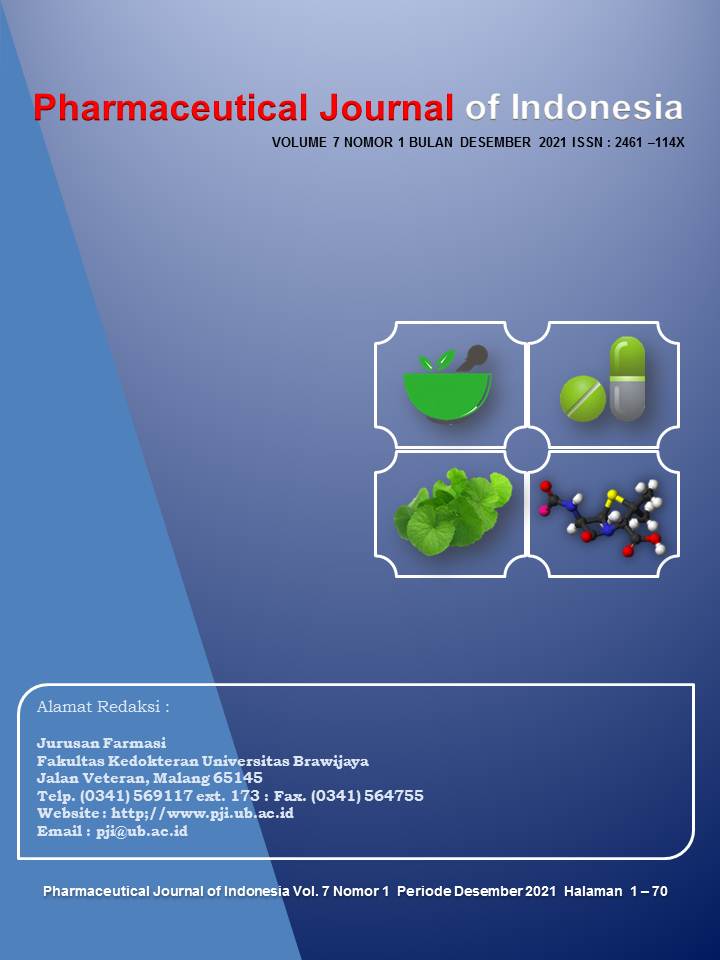Rapid screening analysis of antioxidant activities in green tea products using DPPH and FRAP
DOI:
https://doi.org/10.21776/ub.pji.2021.007.01.2Keywords:
Antioxidant, Camellia sinensis, DPPH, FRAPAbstract
Free radicals are formed inside and outside the body. Free radicals inside the body can be created in the cell compartments. The reactions are complex through the initiation, propagation, and termination stages. On the other hand, free radicals in the outer body can be formed from pollutions and environmental damage action. Excessive free radicals cause oxidative stress and use destructive cellular to affect health conditions. Antioxidants are known as essential agents in biological systems against diseases triggered by free radicals. One of the many antioxidants found in tea plants (Camellia sinensis) is polyphenols. A colorimetry method was employed to evaluate the dominant antioxidant compound of the total phenolic and flavonoid content in two selected tea products. The total phenolic content was determined by utilizing the Folin-Ciocalteu reagent. In addition, an aluminum colorimetric assay is applied to assess flavonoid content. Rapid screening of antioxidant activity using a spectrophotometric method is employed to determine IC50 values of tea extracts utilizing DPPH and FRAP. The FRAP method showed more sensitivity in determining antioxidant activities with the feasibility of working in low analyte concentrations than the DPPH method. The high total phenolic and flavonoid contents found in this experiment are in line with low IC50 values. It was also found out that brewed green tea has lower total phenol content than green tea bags.References
Shahidi F, Zhong Y. Measurement of antioxidant activity. J Funct Foods [Internet]. 2015;18:757–81. Available from: http://dx.doi.org/10.1016/j.jff.2015.01.047
Ghosh N, Das A, Chaffee S, Roy S, Sen CK. Reactive oxygen species, oxidative damage and cell death [Internet]. Immunity and Inflammation in Health and Disease: Emerging Roles of Nutraceuticals and Functional Foods in Immune Support. Elsevier Inc.; 2017. 45–55 p. Available from: http://dx.doi.org/10.1016/B978-0-12-805417-8.00004-4
Antolovich M, Prenzler PD, Patsalides E, McDonald S, Robards K. Methods for testing antioxidant activity. Analyst. 2002;127(1):183–98.
Hilal Y, Engelhardt U. Characterisation of white tea - Comparison to green and black tea. J fur Verbraucherschutz und Leb. 2007;2(4):414–21.
Prakash A. Antioxidant Activity. Medallion Lab Anal Prog. 2001;19(2):1–4.
Pourmorad F, Hosseinimehr SJ, Shahabimajd N. Antioxidant activity, phenol and flavonoid contents of some selected Iranian medicinal plants. African J Biotechnol. 2006;5(11):1142–5.
John B, Sulaiman CT, George S, Reddy VRK. Total phenolics and flavonoids in selected medicinal plants from Kerala. Int J Pharm Pharm Sci. 2014;6(1):406–8.
Kim MJ, Kim JH, Kim JH, Kim YJ. Comparative studies on the antioxidant capacities and catechin profiles of conventional and organic green tea. J Korean Soc Appl Biol Chem [Internet]. 2015;58(4):475–80. Available from: http://dx.doi.org/10.1007/s13765-015-0045-7
Marinova D, Ribarova F, Atanassova M. Total Phenolics and Total Flavonoids in Bulgarian Fruits and Vegetables. 2005;255–60.
Roshanak S, Rahimmalek M, Goli SAH. Evaluation of seven different drying treatments in respect to total flavonoid, phenolic, vitamin C content, chlorophyll, antioxidant activity and color of green tea (Camellia sinensis or C. assamica) leaves. J Food Sci Technol. 2016;53(1):721–9.
Ratih R, Kohar I, Qalbye A, Allaf K, Hadiyat MA. The antioxidant activities of the extracts of red fruit (Pandanus conodeus Lam.) pre-dried by Detente Instantanee Controlee (DIC). Nat Resour Biotechnol. 2015;1:65–75.
Ou B, Huang D, Hampsch-Woodill M, Flanagan JA, Deemer EK. Analysis of antioxidant activities of common vegetables employing oxygen radical absorbance capacity (ORAC) and ferric reducing antioxidant power (FRAP) assays: A comparative study. J Agric Food Chem. 2002;50(11):3122–8.
Amic D, Amic DD, Beslo D, Trinajstic N. Structure-radical scavenging activity relationships of flavonoids. Croat Chem Acta. 2003;76(1):55–61.
Downloads
Published
Issue
Section
License
Copyright (c) 2021 Pharmaceutical Journal of Indonesia
This work is licensed under a Creative Commons Attribution 4.0 International License





